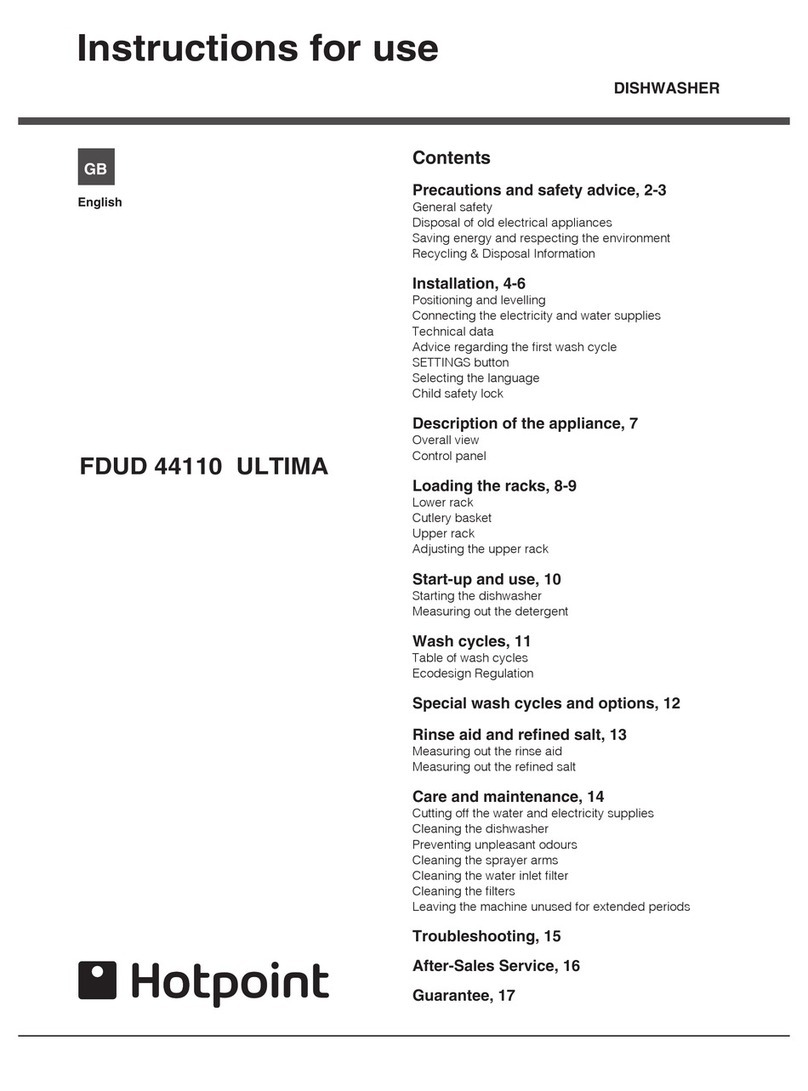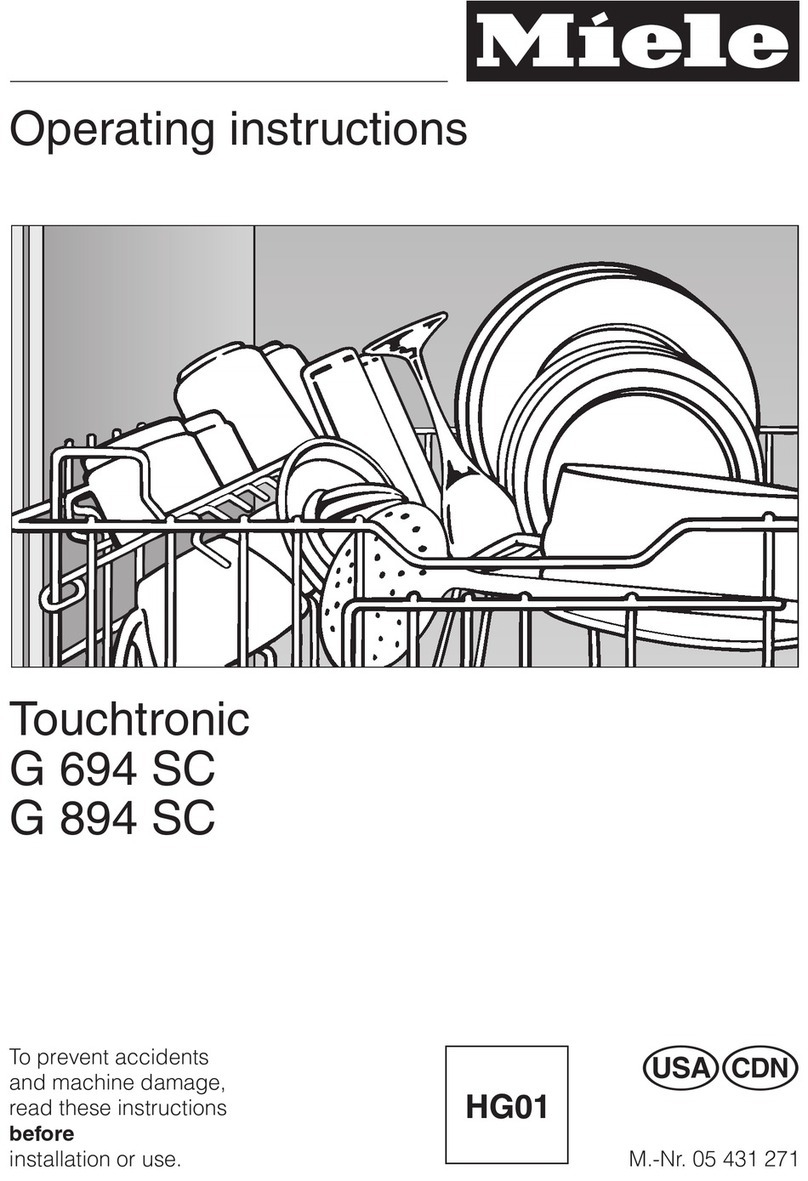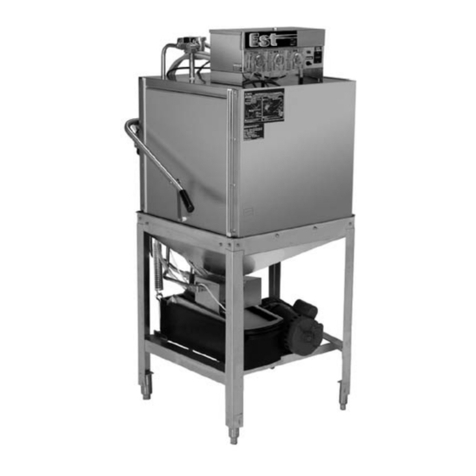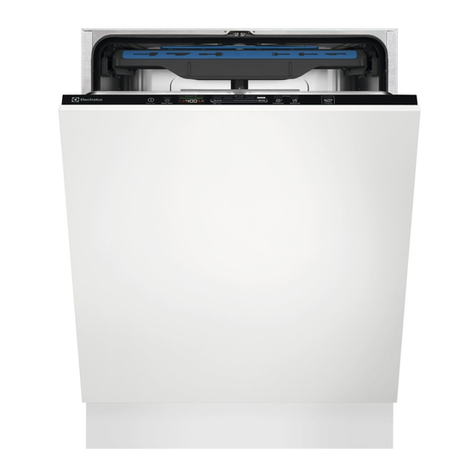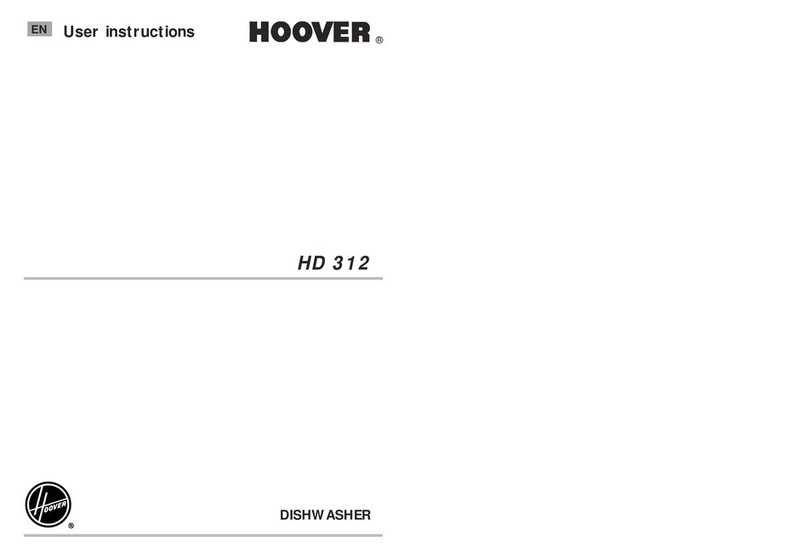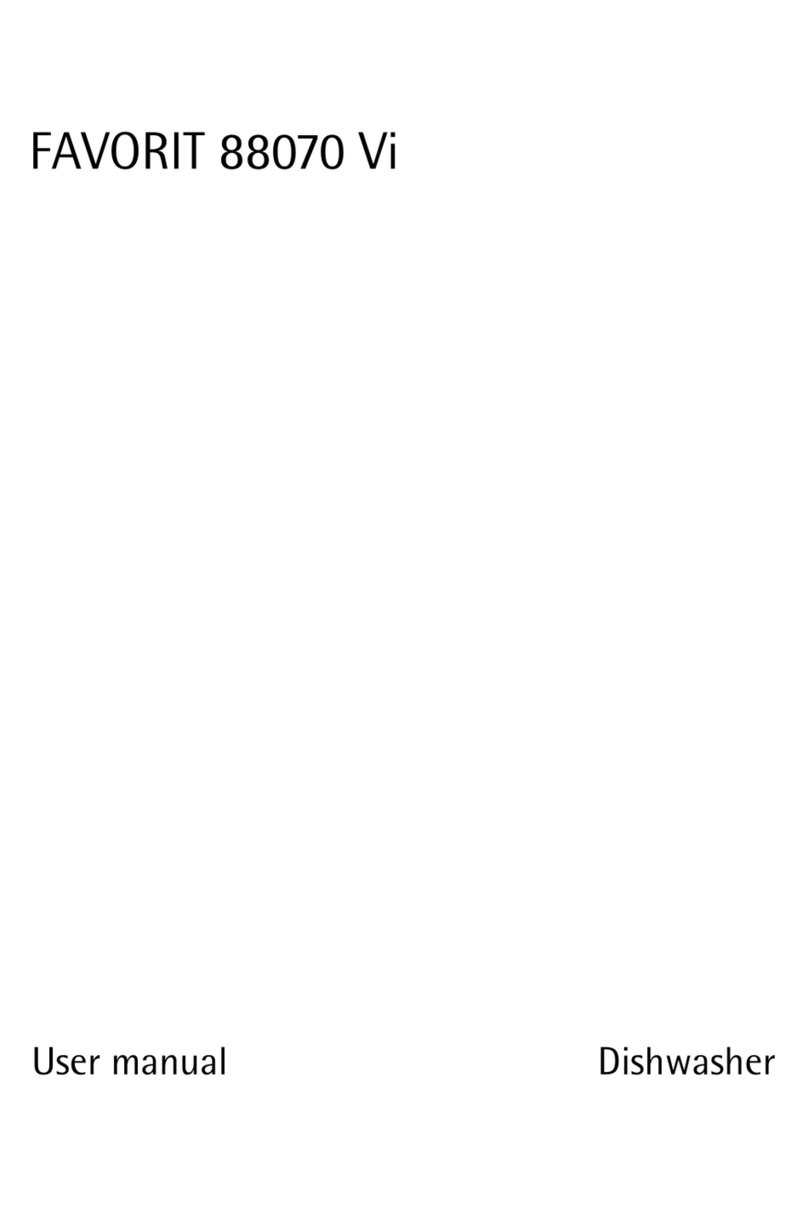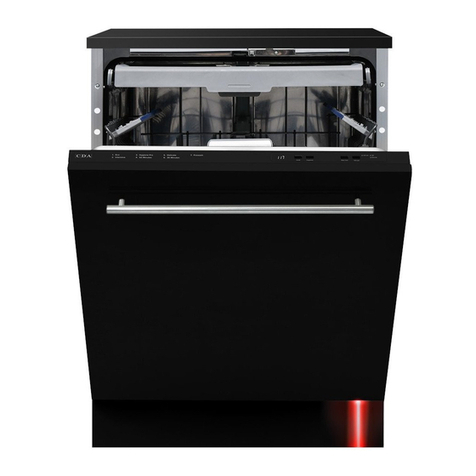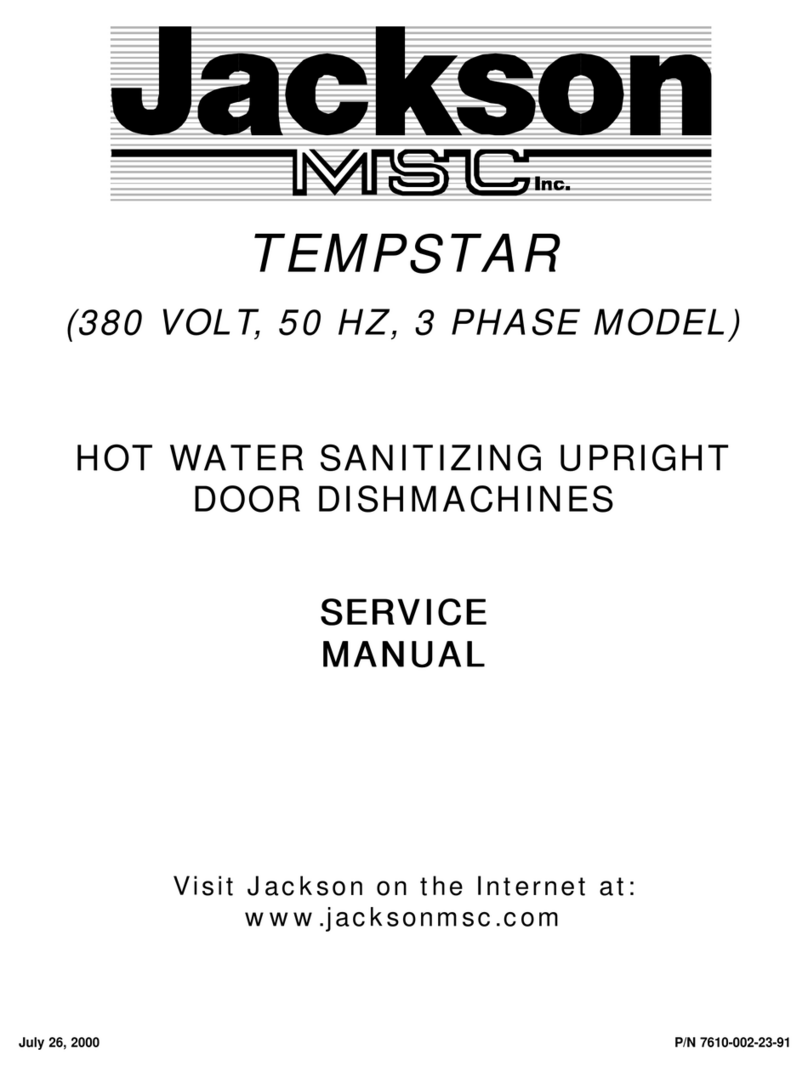Belling IDW604MK2 User manual


IDW604MK2

Witheachwashcycle.
Compartment
For programmes with pre-wash only.
(Follow the user instructions!)
Electric indicator on control panel (if provided).
Check the rinse aid level
(On models with water softener system only.)
Electric indicator on control panel (if provided).
If there is no salt warning light in the control panel
(for some models), you can estimate when to fill the salt into
the softener by the number of cycles the dishwasher has run.
Check the regeneration
salt level
Load the baskets
Select a programme
Close the door, turn on the water tap. The machine will start working after about 10 seconds.
Running the dishwasher
Switch off the appliance
Turn off the water tap,
unload the baskets
Fill the detergent dispenser
Warning: wait a few minutes (about 15 minutes) before unloading the dishwasher to avoid handling
the dishes and utensils while they are stillhot and more susceptible to break.
They will alsodry better.Unload the appliance, starting from the lower basket.
Changing theprogramme
Add forgotten dishes in the
dishwasher.
Scrape off any large amount of leftover food. Soften remnants of burnt food in pans,
then load the baskets. Refer to the dishwasher loadinginstructions.
Press the Programme button until the selected programme lights up.
( See the section entitled Operationg instruction )“”
When the working cycle has finished, the buzzer of the
dishwasher will sound 8 times, then stop.
Turn off the appliance using the ON/OFF button.
If the appliance is switched
off during a wash cycle.
Open the door carefully.
Hotsteam may escape
when thedoorisopened!
If the appliance is switched off during a wash cycle, when switched
on again, please re-select the washing cycle and operate the dishwasher
according to the original Power-on state ).
Switch on the appliance Press the On/Off button to switch on the appliance,Open the door.
1.Open the door a little to stop the dishwasher.
2.After the spray arms stop working, you can open the door completely.
3.Add the forgotten dishes.
4.Close the door, the dishwasher will start running again after 10 seconds.
For detailed operating method read the corresponding content on the instruction manual.
1.A running cycle canonly be modified if it has been running for a short time. Otherwise the detergent
may have already been released and the water already drained. If this is the case, the detergent
dispenser must be refilled.
2. Open the door a little to stop the washing, then press the Program button for more than 3 seconds to
cancel the running programme.
3. Select a new programme, then close the door. The machine will restart after about 10 seconds.

To review the section on troubleshooting Tips
will help you tosolve some common problems
by yourself .
Dear Customer,
Please carefully read thismanual beforeusing the
dishwasher, it will help you to use and maintain the
dishwasher properly.
Pass it on to any subsequent owner of the appliance.
This manual contains sections on safety Instructions,
OperatingInstructions,InstallationInstructionsand
Troubleshooting Tips, etc.
The manufacturer, following a policy of constant
developmentand updating of the product, may
make modifications without giving prior notice.
Keep it to refer to it at a laterdate.
If you can not solvethe problems by yourself ,
please ask forthe help of professional technicians.
Dishwasher Features.................................... ...3
A Water Softener..................... ....................4、..
Attention before or after loading the Dishwasher
Baskets..........................................................9
Filtering System.............................................14
Caring for the Dishwasher..................... .........15.
How to use the 3 in 1 function............................8
B Loading theSalt into the Softener.................5、
C Fill the RinseAid Dispenser.........................5、
D FunctionofDetergent.................................6
、
Loadingthe upper ...............................10Basket
LoadingtheLower ...............................10Basket
Cutlery Basket..............................................11
WashCycleTable...........................................12
Turning on theAppliance................................13
Changethe Programme.............. ................13....
At the End of the Wash Cycle...........................13
Before calling for service........................... .....23.
Errorcodes.................................... ..............24.
Technical information.............................. .....25..
ControlPanel...................................................3
.................................. 16Installation preparation ...17Aesthetic panel's dimensions and installation
..............19Tension adjustmentof thedoor spring
.............................. 19Connection of drain hoses ......................... 20Dishwasherinstallation steps
About Electricity Connecting...........................21
Cold Water Connection.................................. 22
Hot ............. 22Water Connection.....................

This appliance must be grounded. In the event of a
malfunction or breakdown, grounding will reduce
the risk of anelectric shock by providing a path of
least resistance of electric current. This appliance
is equipped with a cord having an equipment-
grounding conductor and a grounding plug.
The plug must be plugged into an appropriate outlet
that is installed and grounded in accordance with
all local codes and ordinances.
Improper connection of the equipment-grounding
conductor can result in the risk of an electric shock.
Check with a qualified electrician or service
representative if you are in doubt whether the
appliance is properly grounded. Do not modify the
plug provided with the appliance; If it does not fit
the outlet. Have a proper outlet installed by a
qualified electrician.
Keep children away from detergent and rinse aid, keep
child away from the open door of the dishwasher,
there could still be some detergent left inside.
ren
Do not abuse, sit on, or stand on the door or dish
rack of the dishwasher.
Do not touch the heating element during or
immediately after use.
(This instruction is only applicable to machines
with a visual heating element.)
Do not wash plastic items unless they are marked
dishwasher safe or the equivalent. For plastic items
not so marked, check the manufacturer's
recommendations.
Useonly detergent and rinse additives
designed for an automatic dishwasher.
Never use soap, laundry detergent, or hand
washing detergent in your dishwasher. Keep
these products out of the reach of children.
During installation,the powersupplymustnot
beexcessively ordangerouslybentorflattened.
Do not tamper with controls.
Do not place any heavy objects the
door when it is open. The appliance could tip
forward.
on or stand on
When loading items to be washed:
1)Locatesharp itemssothat theyarenot likely
todamagethedoorseal;
2 Warning: Knives and otherutensils with
sharp points must be loaded in the basket
with their points down or placedin a
horizontalposition.
)
When using your dishwasher, you should
preventplastic items fromcomingintocontact
withthe heating element.(This instruction is only
applicable to machines with a visual heating
element.)
Ifthesupply cord isdamaged, it must be replaced
by themanufacturer or itsserviceagent or a
similarly qualified person in order to avoid a
hazard.
Please dispose of packing materials properly.
Use the dishwasher only for its intended function.
Remove the door to the washing compartmentwhen
removing an old dishwasher from service or discarding it.
Dishwasher detergentsare stronglyalkaline, they
can be extremely dangerous if swallowed.Avoid
contact with skin and eyesand keep children away
from the dishwasher when the door is open.
Check that the detergent comparment isempty
after completion of thewash cycle.
The appliance is to be connected to thewater
mains using new hose sets and that old hose-sets
should not be reused.
The maximumnumber of place settings to be
washed is 12.
The maximumpermissible inlet water pressureis
1Mpa.
The minimum permissibleinlet water pressureis
0.04Mpa.
Children should besupervised toensure that they do
not play with the appliance.
This appliance is not intended for use by persons
(including children with reduced physical, sensory or
mental capabilities, or lack of experience and
knowledge ,unless they have been given supervision
or instruction concerning use of the appliance by a
person responsible for their safety.
)
When using your dishwasher, follow the precautions listed below:
The door should not be left open,
since this could increase the risk of tripping.
Do not operate your dishwasher unless all
enclosure panels are properly in place. Open
the door very carefully if the dishwasher is
operating, there is a risk of water squirting out.

Disposeof the dishwasher packagingmaterial correctly.
All packaging materialscanbe recycled.
Plastic parts are marked with thestandard international abbreviations:
PE for polyethylene, e.g. sheet wrapping material
PS for polystyrene,e.g.padding material
POM polyoxymethylene, e.g. plastic clips
PP polypropylene, e.g. Salt filler
ABS Acrylonitrile Butadiene Styrene, e.g.Control Panel .
Packaging material couldbe dangerous for children!
Fordisposing ofpackageand the appliance please goto arecycling centre. Therefore cut
off the powersupplycable and makethe doorclosingdevice unusable.
Cardboard packaging is manufactured from recycledpaperand shouldbe disposedin the
waste paper collection for recycling.
By ensuring this product is disposed of correctly, you will help prevent potential negative
consequences for the environment and human health,which could otherwise be caused
by inappropriatewaste handling of thisproduct.
Formore detailed information about recycling of this product, please contact your local
city office and your household waste disposal service.
DISPOSAL: Do not dispose this product as unsorted municipal waste. Collection of such
waste separately for special treatment is necessary.

11 12
Back View
1
2
3
4
5
6
7
8
9
10
on
Of f
Front view
5
Program button:To select one of the sixprograms. .
2
3
4
3in1 and halfload function button: To select andshow 3in1
and Half loadfunctions. (Half load function means that the
lower spray arm does not run, so you should load the upper
basket only ).
Display window: Program remaining time, delay time,
running indicator, Program indicator, Salt and rinse
aid indicator, Error codes, etc.
Power switch: To turn on/off the power supply.
DelayedStartButton:Topresetthewashtimeranddelay
the starting time up to 24 hours.Every press of this button
increases the time by one hour.
for example: one press for an hour, two for two
hours... ...
(
)
MainFilter
Detergent Dispenser
CupShelf
CutleryBasket
CoarseFilter
RinseAidDispenser
Inlet pipe connector
Drain pipe connector
Lower Basket
SprayArms
UpperBasket
1
Salt Container
beforeusing it for the firsttime.
To getthe best performance from yourdishwasher,read all operating instructions
5
6
7
8
9
10
12
11
3
24
1/2
1/2
1/2

Before using your dishwasher for the first time:
The water softener must be set manually, using the water hardness dial.
The water softeneris designed to remove minerals and salts from thewater, which wouldhave
a detrimentalor adverse effect on the operation of the appliance.Thehigher the
content of these minerals and salts, the harder your water is. The softener should be
adjusted accordingtothe hardness ofthe water in yourarea. Your local WaterAuthority
can adviseyou onthehardnessofthewaterinyourarea.
Adjusting Salt Consumption
The dishwasher isdesigned to allow for adjustmentin the amount of salt consumed based onthe hardness of
thewaterused. This is intended tooptimiseand customisethelevel of salt consumption.
1. Unscrew the cap fromthesalt container.
2. There is aring on the container with anarrow on it (see figure
ontheside), ifnecessary, rotate thering intheanticlockwise
direction fromthe "-" Setting toward the "+"sign, based on the
hardness ofthe water being used.
It is recommendedthat adjustments shouldbe made in
accordance withthe following scheme:
WATER SOFTENER
Thehardness ofthe watervariesfrom place to place.If hardwater isused inthe dishwasher, deposits will
form on the dishesand utensils.
The appliance is equipped with a special softener that uses a salt container specifically designed to eliminate
lime and minerals from the water.
Contact your local water board for information on the hardnessof your water supply.
dH mmol/l
0~140~8 0~1.4 /0/
14~398~22 1.4~3.9 - 20 50
39~8022~45 3.9~8 Mid 40 25
+60 16
fH
0~10
10~28
28~56
Clarke
WATER HARDNESS
SelectorPosition Salt consumption
(gram/cycle) Auto nomy
(cycles/1kgs)
Please follow the steps below for adjustment in salt consumption.
""/
"-"
"+"
"Mid"
Settingtowardthe"+"sign
Settingtowardthe"-"sign
Settingtowardbetween
the "-" sign and "+" sign
No salt need added
45~60 80~107 56~75 8~11
If your model does not have any water softener, you mayskip this section.
A. Set the watersoftener
B. Pour 1 2 litre ofwaterinsidethesaltcontainer and then fill withdishwasher salt
/
C. Filltherinseaiddispenser
D. Fill in detergent
°Clark: British degree
°fH: French degree
°DH: German degree
dH=1.25Clarke=1.78fH=0.178mmol/l
°°°
1

normal for a small amount of water to come out of the salt container.Itis
1. The salt container must only be refilledwhen the salt warning light in the control panel comes on.
Depending on how well the salt dissolves, the salt warning light maystill be on even though the
salt container is filled.
If there is no salt warning light in the control panel (for some Models),you can estimate whento fill
the salt into the softener by the cycles that the dishwasherhas run.
2. If thereare spills ofthe salt,a soakor a rapid program should be run to remove the excessivesalt.
Always use the salt intended for use with dishwasher.
The salt container is located beneath the lower basket and should be filled as explained
inthe following:
Attention!
Only use salt specifically designed forthe use indishwashers! Every other type of
salt not specifically designed for theuse in adishwasher, especially table salt, will
damage thewater softener. In case of damages caused by the use of unsuitable
salt the manufacturerdoes not give any warranty nor is liable for any damagescaused.
Only fill withsalt justbefore starting one of thecomplete washingprograms.
This will prevent any grains of salt or salty water, which may have been spilled,
remaining on the bottom ofthe machine for any period oftime, which maycause
corrosion.
The rinse aid isreleasedduringthe final rinse to prevent water from forming droplets onyour dishes, which can
leave spots and streaks. Italso improvesdryingby allowing watertoroll offthe dishes. Your dishwasher is
designed to use liquidrinseaids.The rinseaiddispenser islocated inside thedoor next to the detergentdispenser.
To fill the dispenser,open the cap and pour the rinse aid into the dispenser until the level indicator turns completely
black. Thevolume ofthe rinseaidcontainer is about 110ml.
RinseAid Dispenser
Function of RinseAid
Rinse aid is automatically added during thelastrinse, ensuring thorough rinsing, and spotand streak free drying.
Attention!
Only usebranded rinse aid for dishwasher. Neverfill therinse aid dispenserwithanyothersubstances
(e.g. Dishwasher cleaning agent, liquid detergent).This would damage the appliance.
ARemove the lower basket and then unscrewandremove the capfrom thesalt container.
BBefore thefirst wash,fill 1lt. of water inthe salt container of your machine.
CPlace theend of thefunnel (supplied) into the hole and introduce about 1kg of salt.
DAfter filling the container , screw the cap tightly back clockwise.
EUsually, the salt warning light willstop being illuminated within 2-6 days afterthesaltcontainer hasbeen filled with
salt.
FImmediately afterfilling the salt into the salt container, a washing program should be started
program Otherwise the filter system, pump or other important parts of the machine may be damaged
bysalty water.This isoutof warranty.
(Wesuggest to use the
soak orrapid ).

To open the dispenser, turn the cap to the "open" (left) arrow and lift it out.
Pourthe rinse aid intothe dispenser, being careful not tooverfill.
Replace the cap by inserting italigned with "open" arrow and turning it tothe closed (right) arrow.
Adjusting RinseAid Dispenser
The rinse aid dispenser has six or four settings. Always start with the dispenser
set on "4". If spots and poor drying are a problem, increase the amountofrinse
aid dispensedby removing the dispenser lidand rotating the dial to "5". If the
dishes still are notdrying properly or are show spots,adjustthe dial to the next
higher lever until your dishes are spot-free. The recommended setting is "4".
(Factory valueis "4".)
Increase the dose if there are drops of waterorlimespots onthe dishes after washing.
Reduce itif there are sticky whitishstains on your dishesora bluish film on glassware or
knife blades.
1
2
3
As the rinse aid diminishes, the sizeof the black dot
ontherinse aidlevel indicator changes, as illustrated below.
Full
3/4full
1/2full
1/ 4full -Should refilltoeliminate spotting
Empty
When to Refill the RinseAid Dispenser
Ifthereis no rinse-aid warning lightin thecontrolpanel, youcan estimatethe amount from the colour
of the optical level indicator C located next to the cap. When therinse-aid container is full, the whole
indicator will be dark .As the rinse-aid diminishes, the size of the dark dot decreases. You should never let
the rinse aid level fall 1 / 4 full.
during the nextwash.
Don'tforget to replacethe cap before you closedishwasher door.
Clean up any rinse aid spilled while during filling with an absorbent cloth to avoid excessive foaming
Detergents with its chemical ingredients arenecessary to remove dirt,crush dirt andtransport it outof the dishwasher.
Mostofthecommercial quality detergentsare suitable forthispurpose.
Detergents
There are 3 sorts of detergents
1.Withphosphate andwithchlorine
2.With phosphate and without chlorine
3.Withoutphosphate and without chlorine
""

Amount ofDetergenttoUse
Proper Use ofDetergent
Use only detergentspecificallymade for theusein dishwashers. Keep your detergentfresh and dry.
Don't putpowdereddetergent into the dispenseruntil you'reready towash dishes.
Dishwasher detergent is corrosive! Take care to keepit out of reach of children.
Based ontheir chemicalcomposition, detergentscan besplit in two basic types:
The use of normal washingprograms in combinationwith concentrated detergents
reduces pollution and is good for your dishes; these wash programsare specifically matched
to the dirt-dissolving properties of the enzymes of the concentrated detergent. For this reason
normal wash programsin which concentrated detergentsareused canachievethe same
results that can otherwise onlybe achieved using intensive programs.
“”
“”
“”
Detergenttablets of different brandsdissolve at different speeds. Forthis reasonsome
detergenttablets cannot dissolve and develop theirfull cleaning power during short
programs. Therefore please use long programs whenusingdetergent tablets, to
ensure the complete removal of detergent residuals.
The dispenser must be refilledbefore the start of each washcycle following the instructions
provided in the wash cycle table . Your dishwasher uses less detergent and rinseaid than
Conventional dishwasher. Generally, onlyone tablespoon of detergent is neededfor
anormal wash load. Moreheavily soileditemsneedmore detergent.Alwaysaddthe
detergentjust before starting the dishwasher, otherwiseit couldget damp and will not
dissolve properly.
Concentrated Detergent
DetergentTablets
DetergentDispenser
Always add the detergent just before starting each wash cycle.
Only use branded detergentaidfor dishwasher.
If the lid isclosed: press release button. The lid will spring open.
conventional, alkaline detergents with causticcomponents
low alkaline concentrated detergents with natural enzymes
Normally new pulverised detergent is without phosphate.Thus the watersoftener function of
phosphate is not given. In this case we recommend to fill salt in the salt container even when
the hardness of water is only 6 dH. If detergents without phosphate are used in the case of hard water
often white spots appear on dishesand glasses. In this case please add more detergent to reach
better results. Detergents without chlorine do only bleach a little. Strong and coloured spots will not
be removed completely. Inthis case pleasechoosea program with a higher temperature.
°

Ifyou use 3in1 tablets in other programs, the appliance will not achieve agood performance.
Only the 3in1 function(for the program:intensive/Normal/Eco.) Can be used with 3in1tablets.
Fill the detergent dispenser with detergent.
The marking indicates the dosing levels , as
illustrated on the right:
Theplace of main wash cycle detergent placed ,
MIN means approximately 20g of detergent.“”
Theplaceof pre-wash cycle detergent placed,
approximately 5gof detergent
Please observe the manufacturers dosing and storage
Recommendationsas stated onthedetergent packaging.
Closethe lid and press untilit locks in place.
If the dishes are heavily soiled, place an additional
detergent dosein the pre-wash detergent chamber. Thisdetergent will take effect during the pre-washphase.
A
B
Fill in Detergent
You findinformation about the amount ofdetergent for thesingle programme onthe last page.
Pleaseaware, that according tothe levelsoiling andthe specific hardness of waterdifferencesare possible.
Pleaseobserve themanufacturer's recommendationson the detergent packaging.
When using 3in1 combination / compact Detergents ,pleasepay attention to makesure that
the size of the combination detergents fits to the dispenser so that combination
detergentscan be easilyput into the dispenser, and thedispenser would not be broken.
,
Your dishwasher has a 3in1 function which needs no salt and rinse aid but a 3In1 tablet.
This dishwasher comeswith a 3in1tablet container as an accessory.
1.The figure below shows how to hangthe 3in1 tablet containeron the upper basket.
2. Rotate the upper sprayer andchange the location of the container to ensure the uppersprayer isnot
obstructedby the 3in 1 tabletcontainer. Refer tothe figurebelow forreference.
3. Put the 3in1 tablet intothe container ,then start the 3in1 program.

Cutlery withwooden,horn china or
mother-of-pearl handles
Plasticitems that arenotheat resistant
Older cutlerywith glued partsthat arenot
temperatureresistant
Bonded cutlery items or dishes
Pewter or cooper items
Crystal glass
Steel items subject to rusting
Wooden platters
Items madefromsynthetic fibres
Some types of glassescan become
dull aftera large number of washes
Silver and aluminum parts have a
tendencyto discolourduringwashing
Glazed patterns may fade if machine
washed frequently
Are not suitable Are oflimited suitability
Dishes and items ofcutlery mustnot lie inside oneanother, orcover each other.
To avoiddamage to glasses, theymust not touch.
Load large itemswhich are most difficult to clean intothe lower basket.
The upper basket isdesigned to holdmoredelicate and lighterdishware such as glasses, coffee
andteacups
Long bladed knives stored in an uprightposition are a potential hazard!
Long and/or sharp itemsof cutlery such as carving knives must be positioned
horizontallyin the upper basket.
Please do not overload your dishwasher. This is important forgood resultsand for
reasonable consumption of energy.
Load hollow items suchas cups, glasses, pans etc. With the opening facing downwards so that
water cannot collect in the container or a deep base.
Usea mild detergentthatis describedas 'kind todishes'. If necessary, seekfurther
information from the detergent manufacturers.
Forparticular items, select aprogramwithaslowa temperature aspossible.
Consider buyingutensils which are identifiedas dishwasher-proof.
To prevent damage, do not take glassandcutlery out of the dishwasher immediately
after the programmehas ended.
(For best performance of the dishwasher, follow theseloading guidelines.
Features and appearance of baskets and cutlerybaskets may vary from your model.)
Scrape off any largeamounts ofleftover food.Soften remnants ofburnt food in pans.
It is not necessary to rinse the dishes under running water.
Place objects inthe dishwasher in following way:
1.Items such ascups, glasses, pots/pans, etc. are faced downwards.
2.Curved items, or ones with recesses, should be loaded aslant so that water can run off.
3.All utensils are stacked securely and can not tipover.
4.All utensils are placed in the way that the spray armscan rotatefreely during washing.
Very small items should not be washed in the dishwasher as they could easily fall out of the basket.
To prevent water dripping from the upper basket into the lower basket, we recommend that you
empty the lower basket first and then the upper basket.

The upperbasket is designed tohold more delicate and lighter dishwaresuchas glasses,coffee
and tea cups and saucers, as well as plates, small bowls and shallow pans (as long as theyare
not toodirty).
Position the dishes and cookware so that they will not get moved by the spray of water.
Wesuggest that you place largeitems and the most difficultto clean items are tobe placed into thelower basket:
such as pots, pans,lids, serving dishesand bowls, as shown in the figurebelow.
It is preferableto place serving dishes and lids onthe side of theracks inorder toavoid blocking the rotation ofthe
topspray arm.
Pots, servingbowls, etc, must always be placed top down.
Deep pots should beslanted to allow water toflow out.
Please be reminded that:
The Bottom Basket features folding spikes so that larger or more pots and pans can be loaded.
1
Cups
2
Small serving bowl
3
Large serving bowl
4
Glasses
Saucers
5
6
Dish
Dessertdishes
7
8
Oval platter
10
Soup plates
Dessert dishes
7
9
Dinnerplates
11
Silverware basket
1010
8
99
77
7
1
1
4
1
7
2
3
5
6
1
4
1
4
1

Cutlery should be placed in the cutlery basket withthe handles at the bottom.If the rack has side baskets,the
spoons should be loaded separately into the appropriate slots, especiallylong utensils should beplaced in the
horizontal position at the front of the upperbasket as shown in the picture.
Folding Spikes of Lower Basket
For better stacking of pots and pans,
the spikes can be folded down as
show in the picture right.
Adjusting the Upper Basket
The height of the upper basketcanbe adjusted in order to create more space forlarge utensils
both for the upper/lower basket. The height of theupperbasket canbe adjusted by placing the
wheels on different height of the rails. Long items, serving cutlery, saladservers and knives
should be placed on the shelfso that they do not obstruct the rotationof the spray arms.
The shelf can be folded back or be removed when not required for use.
For personal safety and a topquality cleaning,place thesilverware in the basketmaking surethat:
They donot nest together.
Silverware is placed with thehandles-down.
But place knivesand other potentially dangerousutensils are placed handles-up.
Teaspoons
4
Soup spoons
2
Forks
1
Serving forks
8
Serving spoons
6
Knives
5
3
Dessert spoons
7
Gravyladles
Do not let any item extend
through bottom.
2
452
5
32
3
2
1
1
1
1
1
5554
555
4
632367 3
2
3
4555
1
1
1
1
1
5
4
2
2
3
33
332
2
3
2
2
1
4
4
4
4
8
4
4
4
1

Means: need to fill rinse into the Rinse-Aid Dispenser.
()
*EN 50242 : Thisprogramme isthe test cycle. The information for comparability test
in accordance with EN 50242,as follows:
Capacity: 12 setting
PositionUpper basket: upper wheels onrails
Rinse aid setting: 6
Eco.
Intensive
Normal
(*EN 50242)
For normally soiled loads,
such as ,plates,glasses
and lightly soiled pans.
standarddailycycle.
pots
For lightly soiled loads,such
as plates,glasses,bowls and
lightlysoiled pans.
For the heaviest soiled
loads, such as pots, pans,
casseroledishesand dishes
thathave beensitting with
dried food on themfor a
while.
Ashorter wash for lightly
soiledloads that do not
needdrying.
For dishes that need to be
rinsed and driedonly.
Rapid
Rinse
For lightly soiled loads,
such as glasses,crystal and
fine china.
Glass
Pre-wash(50 )
Pre-wash
Wash (65 )
Rinse
Rinse
Rinse (55 )
Drying
℃
℃
℃
Pre-wash
Wash (40 )
Rinse
Rinse (60 )
Drying
℃
℃
Pre-wash(50 )
Wash (50 )
Rinse
Rinse(65 )
Drying
℃
℃
℃
Pre-wash
Wash (55 )
Rinse (65 )
Drying
℃
℃
Wash (40 )
Rinse ℃
Rinse (45 )℃
Wash(40 )℃
Rinse (70 )
Drying ℃80
130
1.4 22
(or )3in1
5/25g
(or )3in1
5/25g
160 1.2 16
(Or )3in1
5/25g
155 1.05 13
0.8 8
20g. 95 0.8
15
20 g. 30 0.45 12

It is dangerousto open the door when washing, because the hot water may scald you.
When the working cycle has finished, the buzzer of the dishwasher will sound for 8 seconds, then stop.Turn off
the appliance using theON/OFF button, shut off the water supply and open the door of the dishwasher.
Wait for afew minutes before unloadingthedishwashertoavoidhandlingthedishes and utensils while they
are still hot and more susceptible to breakage. They will also dry better.
Switch Off the Dishwasher
The program has ended, only if there appears a "-:--" in the digital display (remaining program time).
1.Switch off the dishwasher by pressing the ON/OFF button.
2.Turnoffthewatertap!
Open thedoor carefully.
Hot dishes are sensitive to knocks. The dishes should therefore be allowed to cool down around 15 minutes
before removing from the appliance.
Open thedishwasher's door, leave it ajar and wait a few minutes before removing the dishes. In this way they
will be cooler andthe drying will be improved.
Unloadingthe dishwasher
It is normal that the dishwasher is wet inside.
Empty thelower basket first and thenthe upperone. This will avoid water dripping from the upper Basket onto
the dishes in the lower one.
the machine will working after 10 seconds.continue
Ifyou openthe door , the machine will pause. When you close thedoor ,during a wash cycle
1 Draw out the lower and upper basket, load the dishes and push them back.
It iscommendedtoloadthelowerbasketfirst,thentheupperone(seethe sectionentitled
Loading the Dishwasher ).
2 Pour in the detergent (see the section entitled Salt, Detergent and RinseAid ).
3 Insert the pluginto the socket. The power supplyis 220-240 VAC /50 HZ, the specification of the
socketis 10A 250VAC. Make sure that the water supply is turnedon to fullpressure.
4 Press the ON/OFF button, and the ON/OFF lightor the display will turnon.Press the program
buttonto select a desiredwash cycle. fter 10 seconds, the machine will work.
“”
“”
Closethe door,a
1 Acycle that is underway can only be modified if it has only been running for a short
time. Otherwise, thedetergent mayhave alreadybeen released, and theappliancemay
have already drained thewash water. If this is the case, the detergent dispenser must
be refilled (see the section entitled " Loading the Detergent " ).
2 Openthe door alittle to stopthe washing. Pressthe programme buttonmore than 3 seconds to cancel the running
programme. Then you can select otherprogrammes (see the section entitled " Startinga wash cycle. . . " ).
3 When you select Intensive/Normal/Eco.Programmes,you can select the 3in1function.
Aforgotten dish can be added any time before the detergent cup opens.
Add forgotten dishes.
Close the door
After the spray arms stop working,you can open the door
completely.
2
3
Open the door a little to stop the washing.
14
5
The dishwasher will run after 10 seconds.
Premise

The filter preventslarger remnantsof food or other objects from getting inside the pum.
Theresidues may block the filter, in this casethey must be removed.
The filter system consists of a coarse filter,a flat (Main filter)
And a microfilter(Fine filter).
Food and soil particles trapped in thisfilterarepulverizedby a
special jet on the lower spray arm andwashed down to drain.
Larger items, such as piecesof bonesor glass, that could block
the drainaretrapped in the coarse filter. To remove theitems
caught by the filter, gently squeeze the tap on the top of this
filterandliftout.
Thisfilter holds soil and food residuesin the sumpareaand
preventsit from being redepositon the dishes duringwash cycle.
Main filter
1
Coarse filter
2
Fine filter
3
2
3
1
Filter assembly
Thefilter efficiently
For best performance and results, the filter must be cleaned regularly. this reason, it isa goodidea to
remove thelarger foodparticlestrapped in the filter aftereach washcycle by rinsing the semicircular filterand
cup under running water. To remove the filter device, pull the cup handle in the upwarddirection.
removes food particles from the wash water, allowing it to be recycledduring the cycle.
For
The dishwasher must never be used without the filters.
Improper replacementof the filter may reduce the performance levelofthe appliance
and damage dishes and utensils.
Step 1 Turn the filter in anti-clockwisedirection,
then lift it up.
:
Step 2 lift the Main filterup:
Step 3 lift theFinefilter up:
When following this procedure from step1 to step 3, the filter system will be removed;
when following it from Step 3 to Step 1, the filter system will be installed.
1
2
3

The control panelcan be cleaned by using a lightly dampened cloth.
After cleaning, make sure to dry it thoroughly.
For the exterior, use a good appliance polish wax.
Never usesharp objects, scouring pads orharsh cleaners onany part ofthe dishwasher.
ProtectAgainst Freezing
1.Cutoff the electrical power to the dishwasher.
2.Turn off the water supply and disconnect the water inlet pipe from the water valve.
3.Drain the water from the inlet pipe andwater valve. (Use a pan to catch the water)
4.Reconnect the water inlet pipe to the water valve.
5.Remove the filter at the bottomof the tub and use a spongeto soak up water in the sump.
please take frost protection measures onthe dishwasher in winter. Every fter washingcycles,
please operate as follows time a
:
- Inspect the filtersfor blocking after every timethe dishwasher has been used.
- By unscrewing the coarse filter, you can remove the filter system. Removeanyfoodremnants and
cleanthefilters underrunningwater.
Remarks:
Cleaning the Filter
CleaningThe Door
To clean the coarsefilter and the fine filter, use a cleaning brush. Reassemble the filter parts as shown in the figures
on thelast page and reinsert the entire assembly in the dishwasher,positioning it in itsseat and pressing downwards.
The entire filter assembly shouldbe cleanedonce a week.
When cleaning the filters, don't knock on them. Otherwise, thefilters could be
contorted and the performance ofthe dishwashercouldbedecreased.
To clean theedge around the door, you shoulduseonly a soft warm, dampcloth.
To avoid penetrationof water into the door lock and electrical components,do not
use a spray cleaner of any kind.
Never use a spray cleaner toclean the door panel as it may damage the door lock
and electricalcomponents.
Abrasive agentsor some paper towels should not be used because of theriskof
scratching or leaving spots on the stainless steel surface.
Cleaning the SprayArms
If your dishwasher cannot work because of the ice,
please contact professional service persons.
It is necessary to clean the spray arms regularly for hard
waterchemicalswillclogthesprayarmjetsandbearings.
To remove the sprayarms, screw off the nut clockwise to
take out the washer on top of the spray arm andremove
thearm.
Wash the arms insoapy and warmwater and use a soft
brush toclean the jets. Replace them afterrinsing them
thoroughly.

Itisrecommend thatyourun awashcycle withthe
dishwasher empty andthen remove the plugfrom the
socket, turn off the water supply and leave the door of
the appliance slightly open. This will help the door
sealstolastlongerandpreventodoursfromforming
withintheappliance.
If the appliance must be moved, tryto keep it in the
verticalposition.Ifabsolutelynecessary,itcanbe
positioned on its back.
Oneofthefactorsthatcauseodourstoforminthe
dishwasher is food that remainstrappedin the seals.
Periodic cleaning with adamp sponge will prevent this
from occurring.
After every wash, turn off the water supply to the
appliance and leave the doorslightlyopen sothat
moisture and odours arenot trapped inside.
Before cleaning or performing maintenance, always
remove the plug from the socket.
Tocleantheexteriorandrubberpartsofthedishwasher,
donot use solventsor abrasive cleaningproducts.
Only use acloth with warm soapy water.
To remove spots or stains from the surface of the
interior, usea cloth dampened withwaterana little
vinegar, ora cleaning product madespecificallyfor
dishwashers.
After EveryWash
Remove the Plug
No Solvents orAbrasive Cleaning Moving theAppliance
Seals
When not in Use for aLongTime
Theinstallation of the pipes
and electrical equipments
should be done by professionals.
Electrical Shock Hazard
Disconnect electrical power
before
installingdishwasher.
Failureto do so can result in
death or electrical shock.
The installation position of dishwasher should be near the existing inlet and drainhoses and
powercord.
One side of thecabinetsinkshould be chosen tofacilitatethe connectionof drainhoses of
the dishwasher.
Installation preparation
Note: please checkthe accompanying installation accessories(hook for aesthetic panel,screw)
●
Table of contents
Other Belling Dishwasher manuals
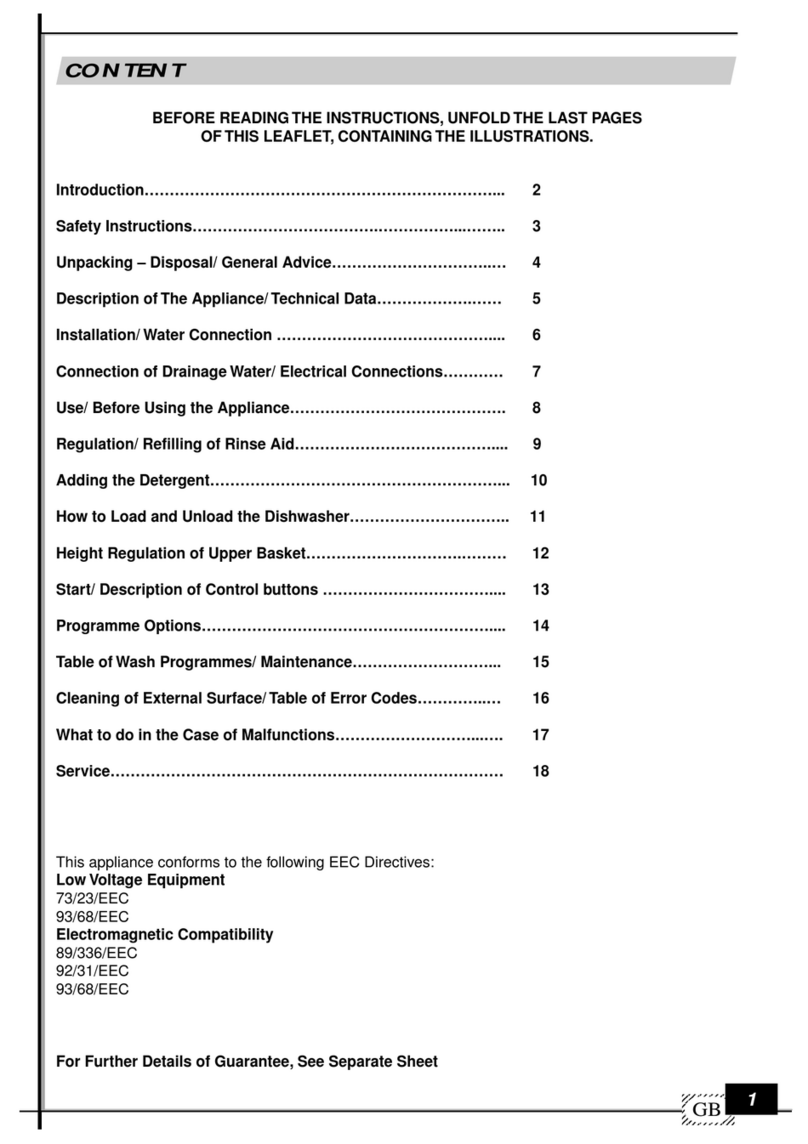
Belling
Belling IDW603 Instruction manual
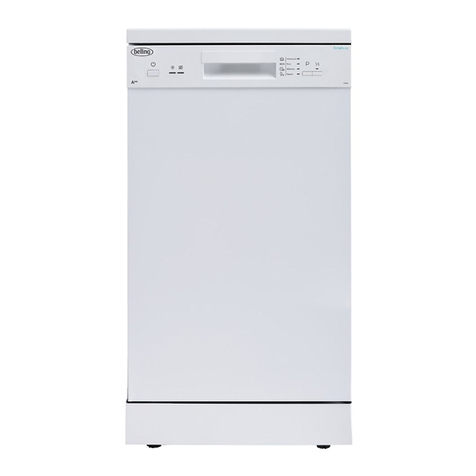
Belling
Belling BEL FDW90 WHI User manual
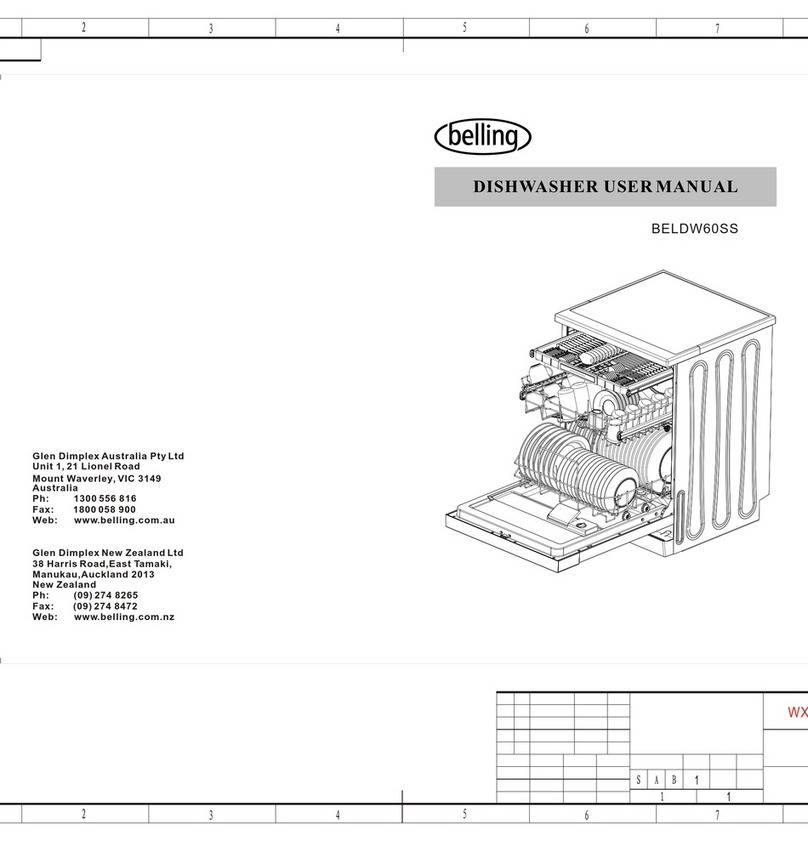
Belling
Belling BELDW60SS User manual

Belling
Belling bdw60ss User manual
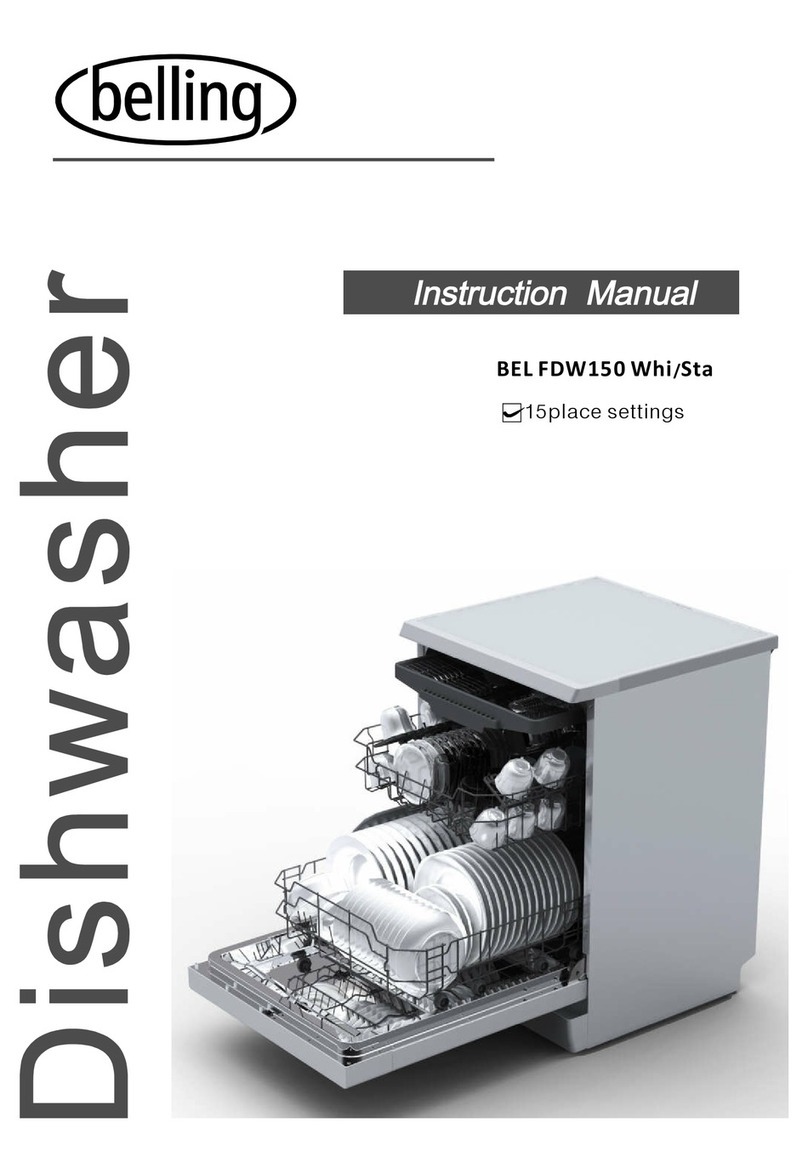
Belling
Belling BEL FDW150 Whi Sta User manual

Belling
Belling BEL IDW45 User manual
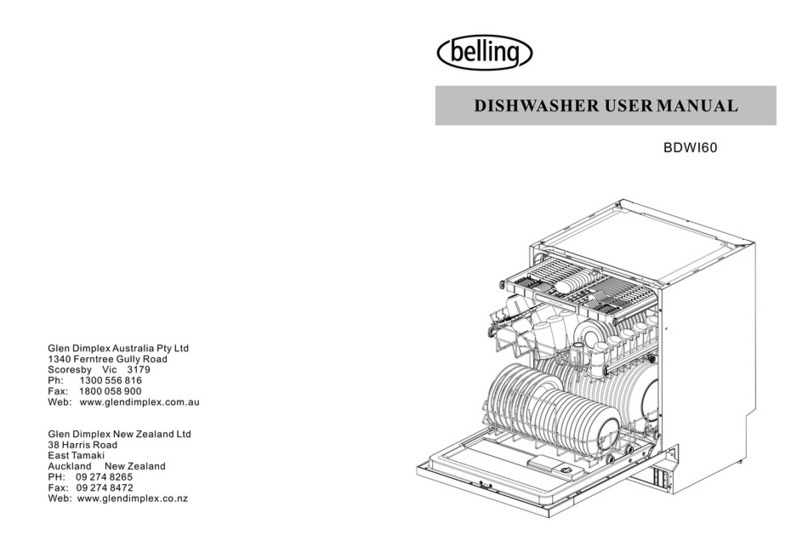
Belling
Belling BDWI60 User manual

Belling
Belling BDW60IC User manual

Belling
Belling BDW60WTE User manual
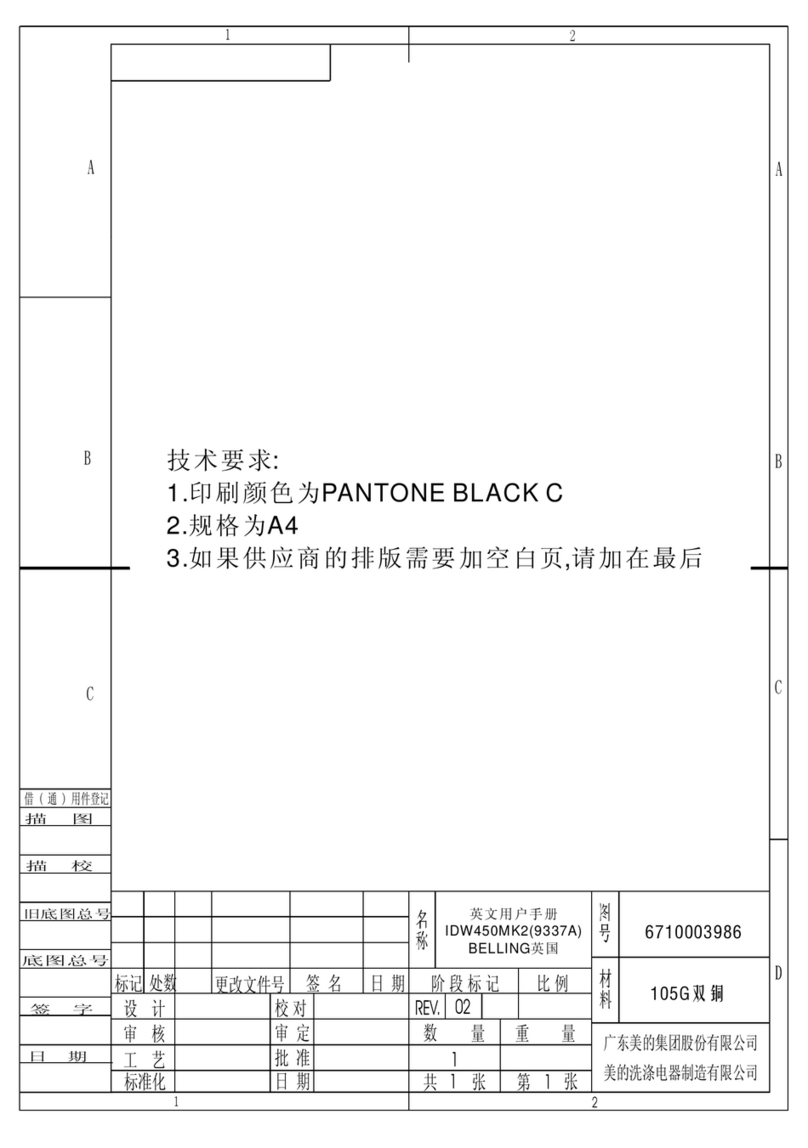
Belling
Belling IDW450MK2 User manual
